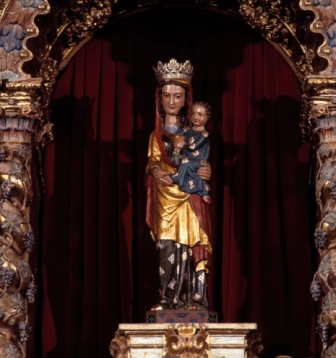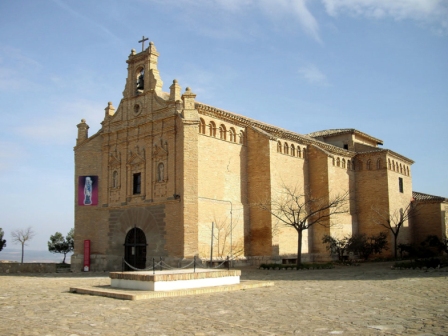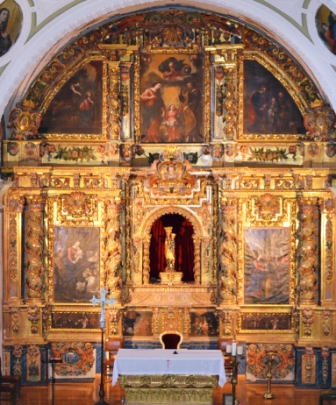September 4, 2014
lecture
Centuries of Art and Devotion around the Virgin of the Yugo
D. Ricardo Fernández Gracia
Chairof Navarrese Heritage and Art
Legendary and secular devotion
The origin of the secular devotion to the Virgin of the Yoke, in Arguedas and in other localities of the zone, is lost in the time, without being able to be specified the date of the legend of its appearance, that the popular imaginary places there by the year 1189, date that was made to coincide in 1889 with the singular celebrations in the sanctuary on the occasion of the ephemeris of the thirteenth centenary of the III Council of Toledo.
The legend, beautiful as many others, has elements that are repeated in numerous Marian advocations: the tree (a pine tree), a farming tool (the yoke), the apparition, the initial incredulity of the neighbors, the miracle in the devout person (a lame farmer) and the reception and reception of the image by the authorities and the whole town. The first historical testimonies take us to half of century XIV, when the mayor of Arguedas bought a piece to the workers of "Sancta Maria del Iugo". The same sculpture is dated in the second half of the 14th century and Fernández-Ladreda puts it in relation to the images of the Virgin of the milk, with the well-known gesture of the Boy taking his arm to the maternal breast that remains modestly hidden by the clothes.
The feast of the apparition was traditionally celebrated on March 25, the day of the Incarnation, which was moved to the second day of Easter if there was an impediment because it coincided with Holy Week. In 1863 the town vowed to celebrate sung mass with sermon on the day of the Dulcísimo Nombre de María. Until that year there were many other festivities with visit to the sanctuary, such as the day of San Gregorio and the Cross of May, practices that were suppressed by the reduction of the chapter. Among the most important dates related to her cult, we must also mention the year 1795 when she was named patron saint and advocate of the Battalion issue 10 of the Volunteers of Navarre, with a great celebration.

Our Lady of the Yoke
Second half of the 14th century
Regarding the rogations and extraordinary transfers to the parish, we will mention some of them. In 1817, it was done at the request of the farmers and cattle ranchers of the town, taking into account "the hardships that are being experienced in the fields and pastures due to the extraordinary shortage of rain ..., they have resolved to renew the rogation ... taking and carrying to the parish the miraculous image of Our Glorious Patroness and Protector the Mother of God of the Yoke, so that with her powerful intercession the fields and pastures are redeemed with the necessary rain in the present calamity and shortage" . In 1834, in a context of plague and war, the same was done with a municipal decree, ordering "that all the neighbors attend at nine o'clock and average attend to the rogatory mass to be celebrated in this church in front of Our Lady, and that no neighbor go to work until after noon".
The image was brought back down to the parish church at different times in the 19th century. In 1854-1855 on the occasion of the morbid cholera and in 1889, to celebrate the VIII Centenary of the apparition, with a great concentration of 8,000 people from the town, Villafranca, Milagro, Cadreita, Valtierra, Carcastillo, Murillo el Fruto and Mélida.
Among the last exits we will mention those of 1936, on the occasion of the Civil War; 1946, for attend to the coronation of Santa Maria la Real in Pamplona; 1952, to proceed to its restoration in Madrid, by the way quite unfortunate; 1981, by works in the Shrine of Our Lady of Fair Love; 1989, to celebrate the IX Centenary of the apparition; 2000, by the Jubilee and 2010 in that besides visiting Arguedas it did it, for the first time, to Valtierra and Cadreita.
As for brotherhoods, we have news of three. The first one established in 1728, with graces and indulgences granted by Benedict XIII, by means of papal bull of April 17 of that year. The neighbors of Arguedas and other towns integrated it. The second one, with degree scroll of Brotherhood of the Virgin of the Yoke, was founded in 1893 and it was composed by priests. The third one was constituted in 1927, with statutes approved by the bishop of the diocese don Mateo Múgica on February 7, 1928.
The sanctuary and its decoration
The most evident and palpable sample of such intense devotion is the sanctuary, secularly denominated as basilica and the one who took care of it as "basiliquero". The present building is based on a previous one that was very deteriorated in the second half of the 16th century. In 1585, the ecclesiastical and secular councils decided "that the Shrine of Our Lady of Fair Love and holy house of Our Lady of the Yoke, which is one of the three basilicas, is very old and in great danger of falling and because the devotion to it should not be lost, but rather increased, because this will increase its income and alms, it is necessary to finish building and constructing the church and Shrine of Our Lady of Fair Love , which has already begun to be built". The one in charge of undertaking the work was the master Juan Miguel de Bara, from Tudela, for the amount of 1,050 ducats. Because he died and took over other factories in Valtierra, he did not finish the work. At the beginning of the XVII century, from 1602 the works were resumed by the stonemason Pedro de Arrese, native of Gaviria, who settled for years in Arguedas and charged 8,000 reals.
To that constructive phase of the end of the XVI century and beginnings of the following century corresponds the nave. The head and the Wayside Cross with its elliptical dome and toral arches of decoration with plasterwork of Aragonese filiation, are product of an extension of the sanctuary that carried out the master of Corella Pedro Aguirre in 1679. A third phase of works consisted of the addition of the sacristy and the chapel, works that were designed in 1716 by the overseer of works of the bishopric Juan Antonio San Juan. position Finally, in 1754, the master builder of Corella José de Argos took over the construction of the choir and remodeling of the façade, after the collapse and ruin of the choir in 1751.

Basilica of Our Lady of the Yoke
Of the set of altarpieces and paintings, the decoration of the chapel and the main altarpiece stand out today. The latter, with elegant salomónicas and richly polychrome fleshy decoration, was made in 1679 by two famous masters from Tudela, who at that time also made the main altarpiece of the Rosario de Corella: Sebastián de Sola y Calahorra and Francisco Gurrea. Its gilding and polychromy was the work of the Aragonese Francisco del Plano in 1684, carried out with delicacy and neatness, according to a contract in which all subject of details were recorded. The canvases are the work of Vicente Berdusán, although those of the main body are very retouched and have lost the fieriness and luminosity of the 17th century.
The dressing room, at the level of the temple as was done in Navarre for the most part, is decorated with fresco paintings of 1728 by José Eleizegui y Asensio, which constitute one of the most interesting scenographic sets of the Baroque in Navarre.
Some notable pieces of the ornamentation of the Shrine of Our Lady of Fair Love have disappeared, such as the organ made in 1801 and the internship totality of the jewels of the Virgin that, according to the inventories of the XVII and XVIII centuries, were rich and without comparison for their variety and abundance with other Marian images of the time.

Basilica of Our Lady of the Yoke
Main altarpiece. 1679
Sebastián de Sola y Calahorra and Francisco Gurrea
Ex-votos, sacred oratory and devotional engravings
Exceptionally, a couple of very interesting votive offerings have been preserved, one in relation to a hunter from 1719 and another dated 1696 that represents the interior of a Madrid house, that of the arguedano Don Esteban de Cegama, the king's accountant, whose wife was healed after invoking the Virgin of the Yoke. The canopied bed, the altar with its dais, the bedroom, the paintings of the Soledad and the landscapes, together with the royal portrait and the mirror, are an excellent example of what the interiors of the Court houses were like in the time of Charles II.
The Virgin of the Yugo was the subject of important pieces of sacred oratory. We know of sermons published in the XVII and XVIII centuries. In 1709 a sermon to the Virgin of the Yugo was published in Madrid, with degree scroll of The Divine Enchantress, preached by the Navarrese Jesuit José Miñano, which we could call a true golden peak of the moment. It is dedicated to Doña Simona de Azcona, who is pompously titled as "hostess of the queen" and who appears in the royal household's list of toilet owners, together with Doña Beatriz de Valenzuela. Another sermon was published in Pamplona by the prolific Franciscan Friar Buenaventura de Arevalo in 1754 with degree scroll of "La graciosísima Serrana. The city on the mountain above all the mountains. The universal protector, the most miraculous Image of Mary with the kind degree scroll of the Yugo". In 1795 the sermon to the Virgin of the Yugo dedicated to the lieutenant colonel of the Navarre Volunteers was also published.
There was no shortage of engravings in the sanctuary to spread the cult of the Marian invocation of the Yugo, with the passage of the apparition to the lame farmer. Among the intaglio prints we will highlight the one illustrating the sermon of 1754, of which multiple printings were made, the work of the Pamplona silversmith and engraver Juan José de la Cruz. plenary session of the Executive Council Its success explains that in the 19th century the same model was lithographed in the Pamplona establishment of Sixto Díaz de Espada in 1871, together with the ancient gozos of the Virgin, previous to those of the novena of Fray Juan Resa, popularized in the monograph of the sanctuary written by Lino Munárriz, published in 1870 and reedited in 1898.
